Before 1990
A border right through the middle of a village – the reasons for that separation date centuries back. In 1810, new border markings were placed along the Tannbach creek banks. The initials “KB“ (Kingdom of Bavaria) were carved into the stones on the western bank, whilst “FR“ (Principality of Reuss) was carved into the border blocks on the eastern bank. These markings indicate Mödlareuth's territorial affiliations up to this day.
After the end of World War I, the western part of Mödlareuth became part of the newly founded federal state of Bavaria and the eastern part became part of the state of Thuringia. However, the Tannbach continued to exist as a border, a purely administrative border that hardly affected the everyday life of the Mödlareuthers. The inn and school were located in the Thuringian part of Mödlareuth, and people went to church together in the neighboring Bavarian town of Töpen. And they went to war together.
At the end of World War II, Germany was divided into four occupation zones. According to the Allies' "London Protocols" of 1944, the demarcation lines ran largely along the old national borders within the German Reich from 1937. This definition of the demarcation lines was to be of serious importance for Mödlareuth, and the border "in" the Tannbach creek took on a previously unimagined dimension. In the Mödlareuth area it now formed the demarcation line between Mödlareuth-East in the Soviet and Mödlareuth-West in the American occupation zone.
However, a curiosity occurred that would last for over a year. After the Americans occupied Mödlareuth without a fight on April 15, 1945 and continued their troop movements towards Thuringia and Saxony, they withdrew to their assigned occupation zone at the beginning of July. When doing so, the US troops did not only vacate the Thuringian part, but also the Bavarian part of Mödlareuth, which was actually situated in the American occupation zone.
On July 7,1945, the Soviet army marched in and established their local command on the Bavarian side of Mödlareuth, soon called “Stalinburg“ by the locals. A red Soviet star was installed on the roof, brightly illuminated at night. A picture of Stalin adorned the entrance. The numerous arrested illegal border trespassers were temporarily detained in the barn next to it. A Soviet boundary barrier and guard house was installed at the Bavarian village exit. But when new bilingual (Russian-German) passports were handed out, the hope for an imminent change of the situation faded. That state of uncertainty persisted for almost a year. Finally, on July 26, 1946, the Russian troops retreated back behind the boundaries of the Tannbach creek due to the urging of the Americans. The western part of Mödlareuth was now occupied by the Americans.
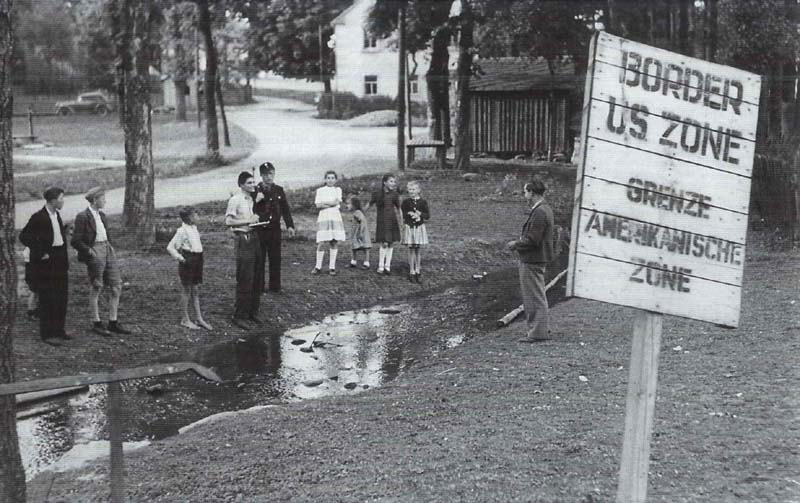
The Tannbach as the demarcation line between East Mödlareuth in the Soviet occupation zone and West Mödlareuth in the American occupation zone, 1948. © Bundesarchiv Koblenz, Bild 183-N0415-363 ׀ Foto: Herbert Donath
With the founding of the two German states in 1949, the eastern part of Mödlareuth now belonged to the territory of the GDR, the western part to that of the Federal Republic. This meant that both parts of Mödlareuth not only became part of two different states, but also of different political, military, economic and societal systems.
At that time, it was still possible to cross the Tannbach with a pass and a “small border permit”. This changed suddenly on May 26, 1952 with the decision of the Council of Ministers of the GDR on the “Ordinance on measures on the demarcation line between the GDR and the western occupied zones of Germany”. This finally sealed the division of Germany. A 10 m wide control strip was created along the demarcation line, trespassing resulted in the use of firearms. The GDR hinterland near the border was divided into a 500 m protective strip and a 5 km restricted zone. Social life was severely affected by measures such as night curfews and bans on gatherings. The GDR built the first border fortifications, which were continually expanded, perfected and therefore more impermeable over the next four decades.
At the beginning of June 1952, the first wave of forced resettlement began along the inner-German border under the code name “Vermin”. Thousands of GDR citizens were relocated from areas near the border to the inland, and some of their houses and farms were razed to the ground. Along with three other families, the residents of the Upper Mill in East Mödlareuth were the first to be affected. Its owners had renovated this fully functioning business just eight months earlier. With the evacuation in sight, the residents of the mill were able to escape at the last minute by jumping through the stable or hayloft window into the western part of Mödlareuth, while the evacuation commission was already in the inner courtyard of the property. A little later the Upper Mill fell victim to the pickaxe. It was to share this fate with many other buildings at the border with the Federal Republic - individual houses, but also entire towns, were demolished and their residents resettled from the GDR border area.
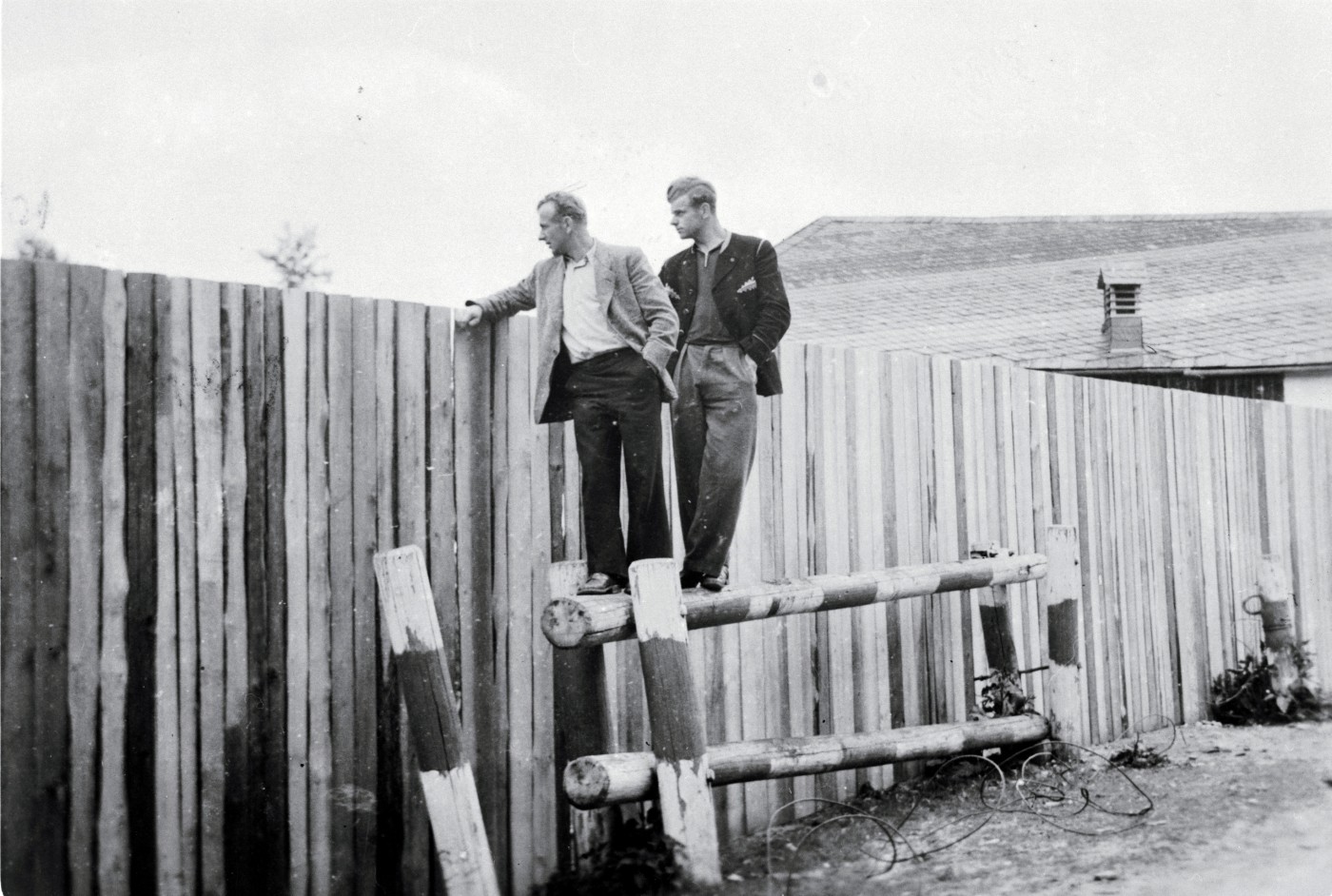
June 1952: Two men look over the recently built wooden fence from West-Mödlareuth into GDR territory © Museum Mödlareuth ׀ Foto: Friedrich Marx
With the Council of Ministers' decision and the Police Regulation that came into force a day later, the "Iron Curtain" also came down in Mödlareuth. In June 1952, the complete demarcation between the two districts was initiated with the construction of a wooden fence that was more than head high. Centuries-old economical, social and family-related connections across the Tannbach came to an abrupt standstill.
Over the next few decades, the barriers in Mödlareuth were continually modified and “improved”. Six years after the wooden board fence was erected, it was replaced by a “Flanders fence,” a construction made of wooden posts and barbed wire mesh. In 1961, the year the Berlin Wall was built and the second major wave of forced resettlement, a single row of barbed wire fence on concrete pillars was built, which was supplemented a year later by two additional rows of barbed wire on concrete pillars. But this “peace border” was not yet secure enough in Mödlareuth. In 1964, the pioneers of the NVA border troops got to work again. Not only the pathway, but also visual contact between East and West should be prevented by a slab wall made of concrete and wooden elements with steel deflectors.
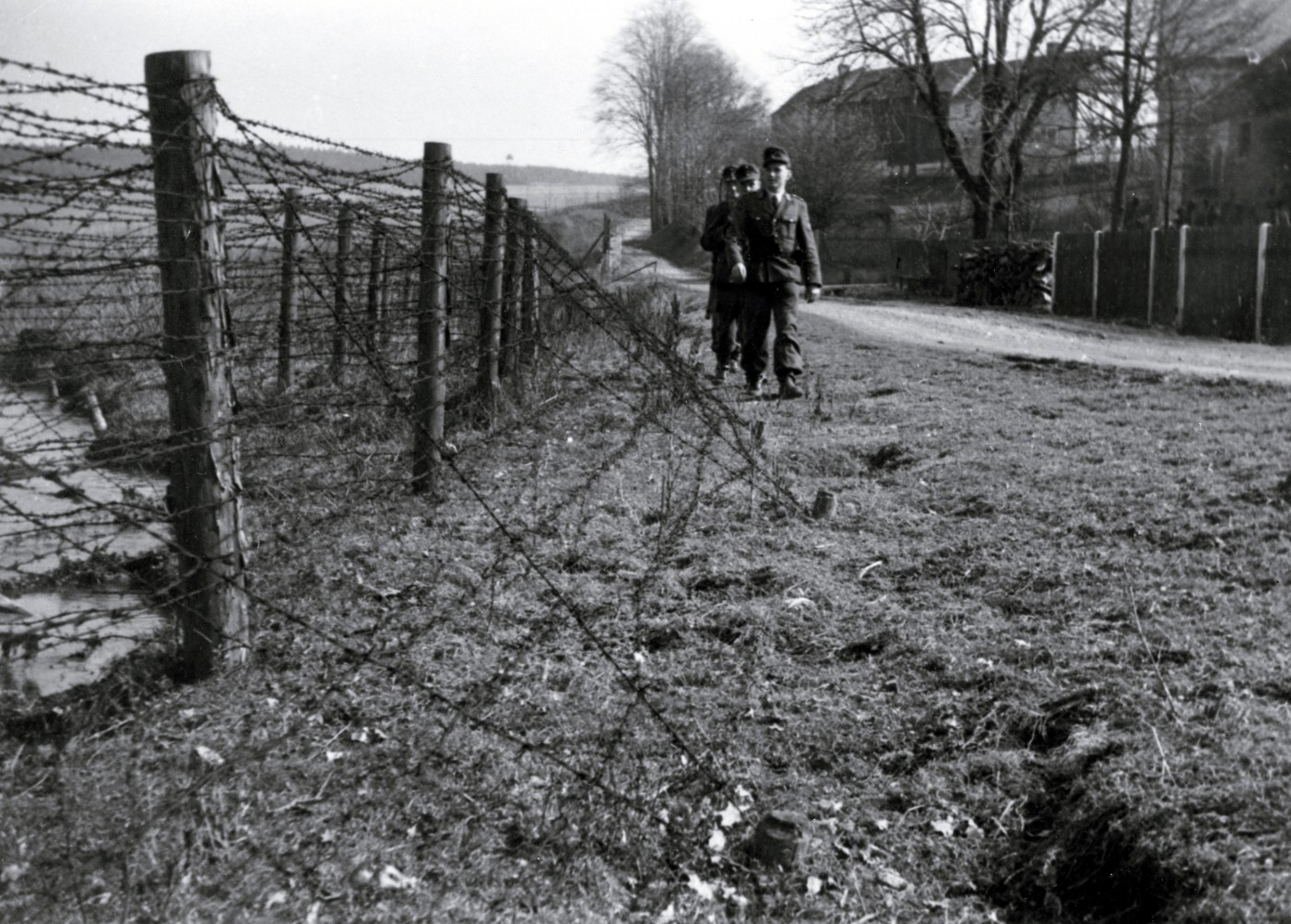
1958: „Flandernzaun“ a fence consisting of a barbed wire construct on wooden stakes © Museum Mödlareuth ׀ Photo: BGS Bayreuth 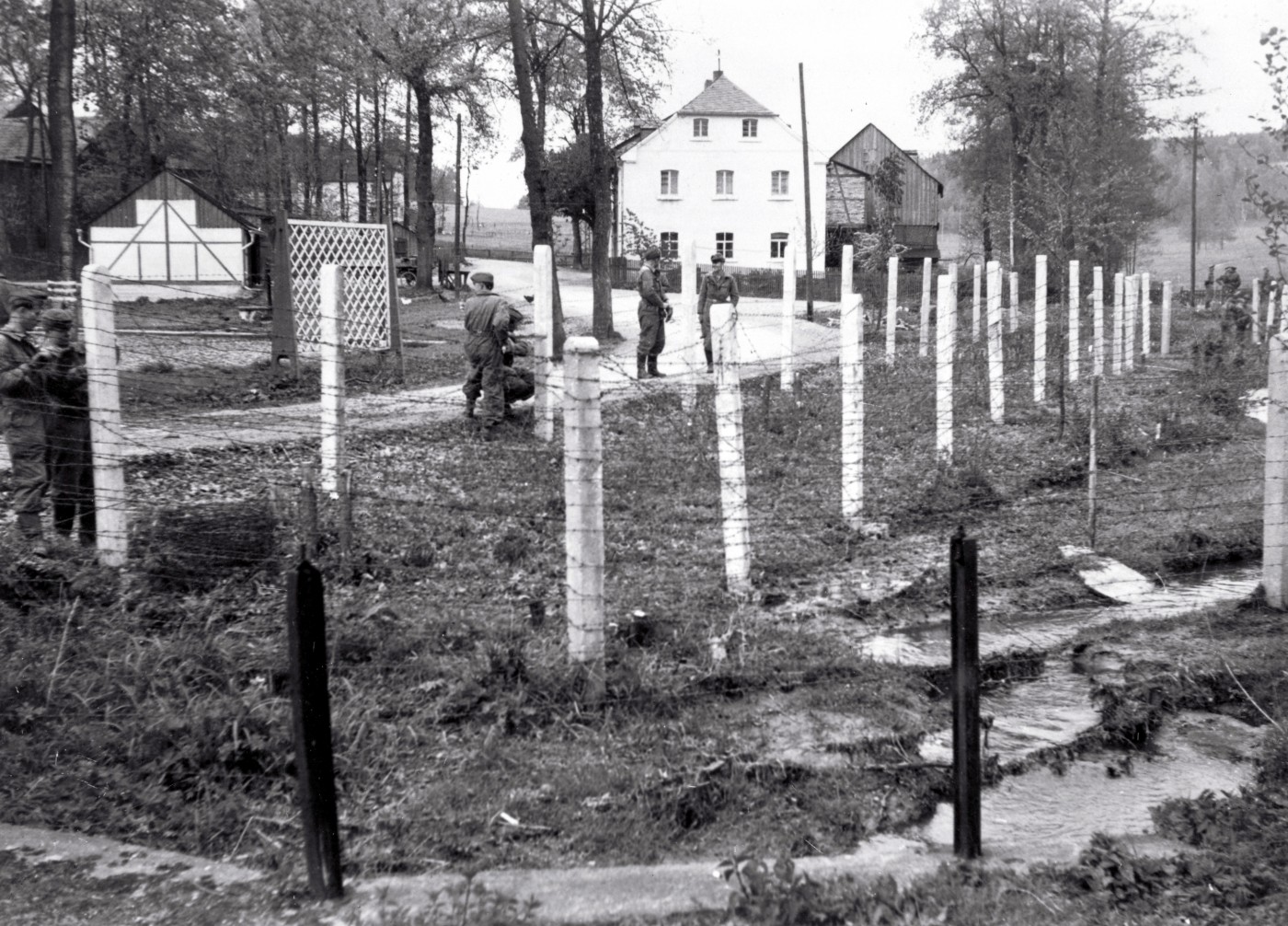
1962: Two-row barbed wire fence with concrete stakes © Museum Mödlareuth ׀ Photo: BGS Bayreuth 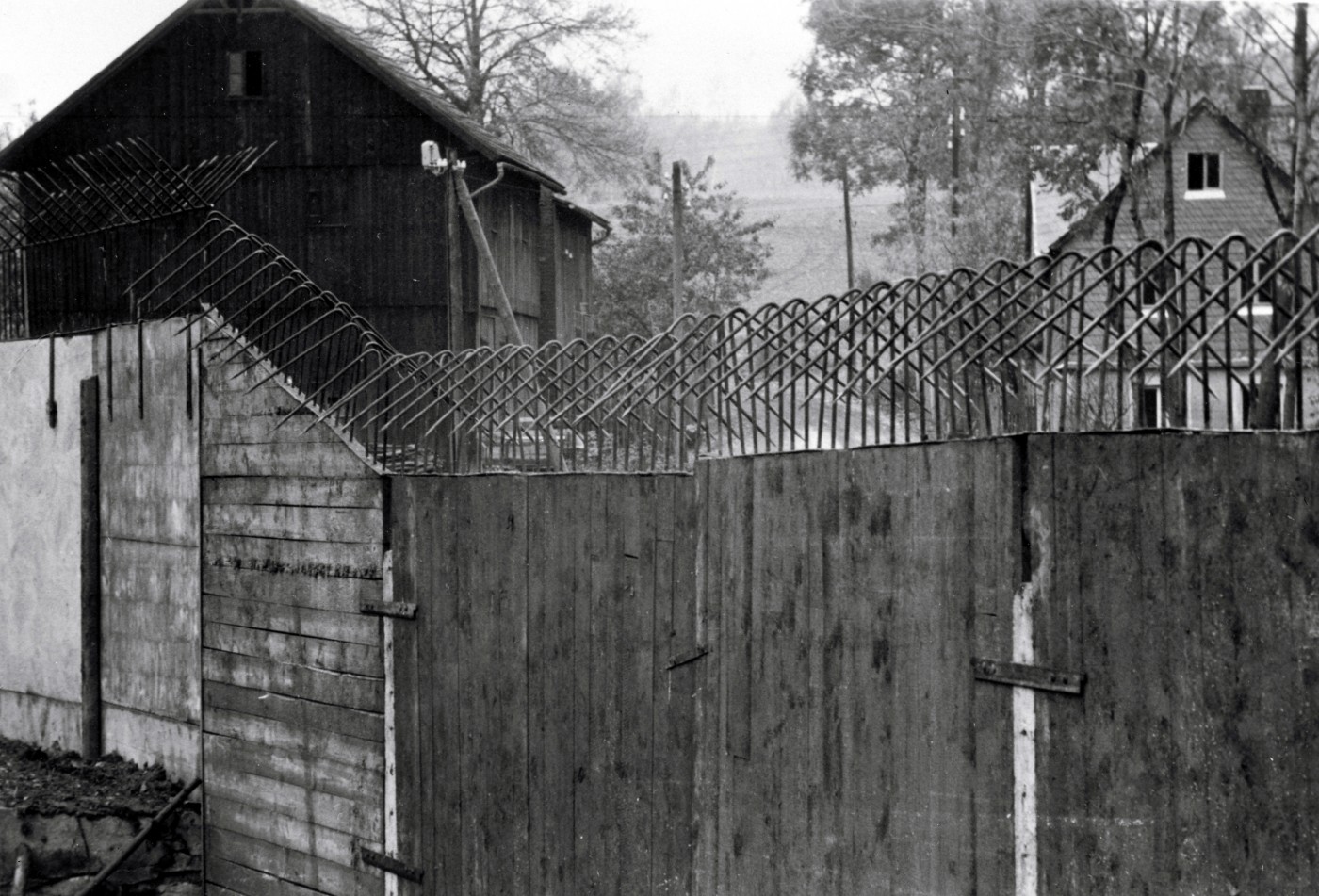
1964: Slab wall made from concrete and wooden elements and steel deflectors © Museum Mödlareuth ׀ Photo: BGS Bayreuth
The culmination of efforts to protect its own citizens from “imperialism” was the construction of the 700 m long, 3.30 m high concrete barrier wall. In 1966, five years after the Berlin Wall was built, it was built in just a few weeks from precast concrete elements. The order to build the Mödlareuth Wall was given on November 23, 1965. Extensive preparatory work began three days later. Building materials, gravel and concrete slabs were delivered for days, holes were dug and concrete foundations were laid. Interrupted due to the strong winter, construction work could not be continued until mid-February 1966. The actual construction of the wall began on April 5, 1966 and lasted until June 15, 1966. The final work followed in August 1966, when an observation point was added to the wall. Later, Mödlareuth was also called “Little Berlin”.
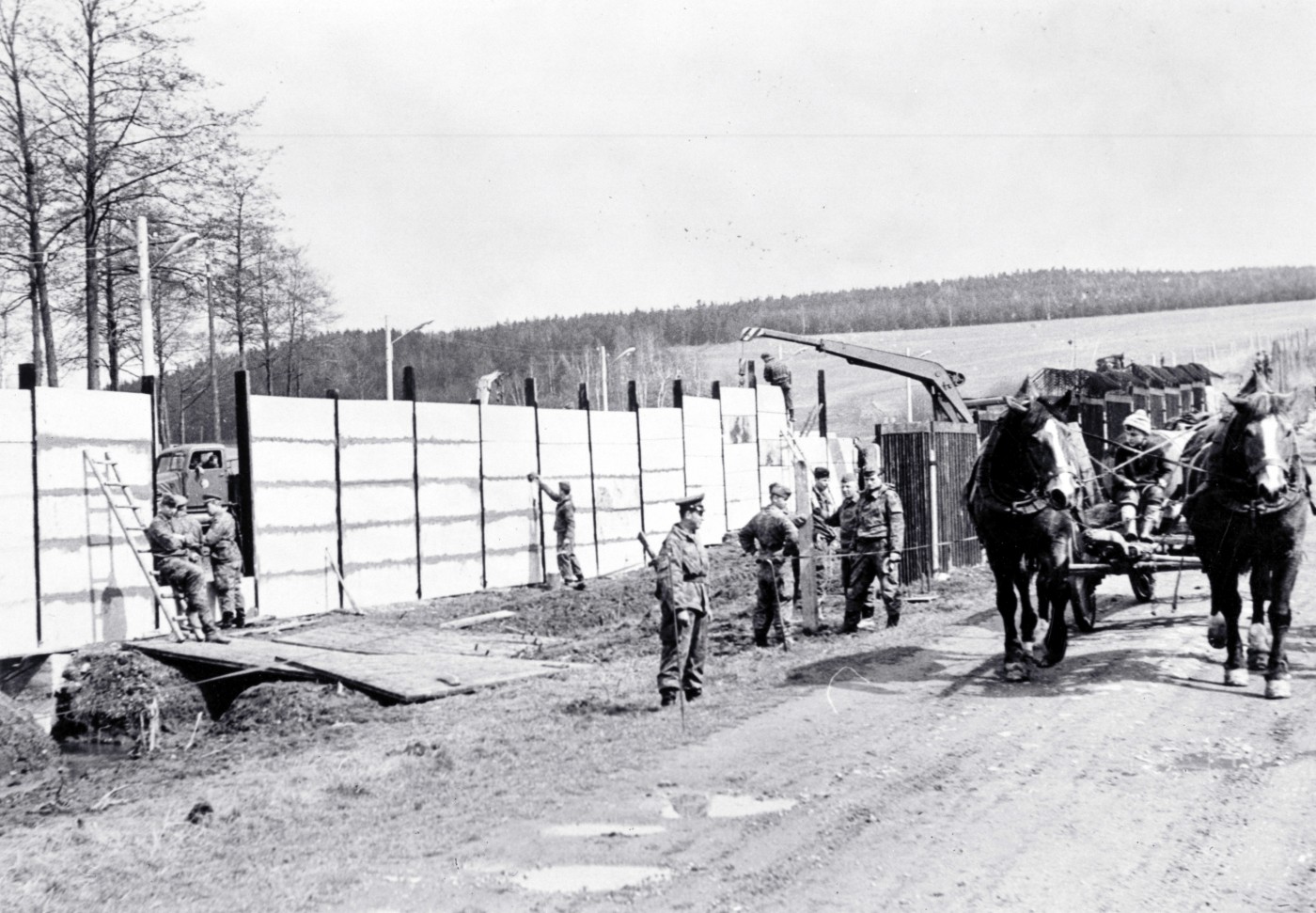
1966: Construction of the 700 m long concrete barrier wall © Museum Mödlareuth ׀ Photo: BGS Bayreuth
On May 25, 1973, the only successful escape over the Mödlareuth Wall took place. A driver from Göttengrün (Schleiz district/Thuringia), using his local knowledge and his permit, managed to drive unhindered to the concrete wall of Mödlareuth and overcome it with the help of a self-made iron ladder, which he placed on the roof of the car. Although the pair of guards on the old wooden observation tower only noticed the vehicle very late, both members of the border troops refrained from using their firearms. Through a chain of fortunate circumstances, the then 34-year-old managed this spectacular "escape from the Republic" without any incidents.
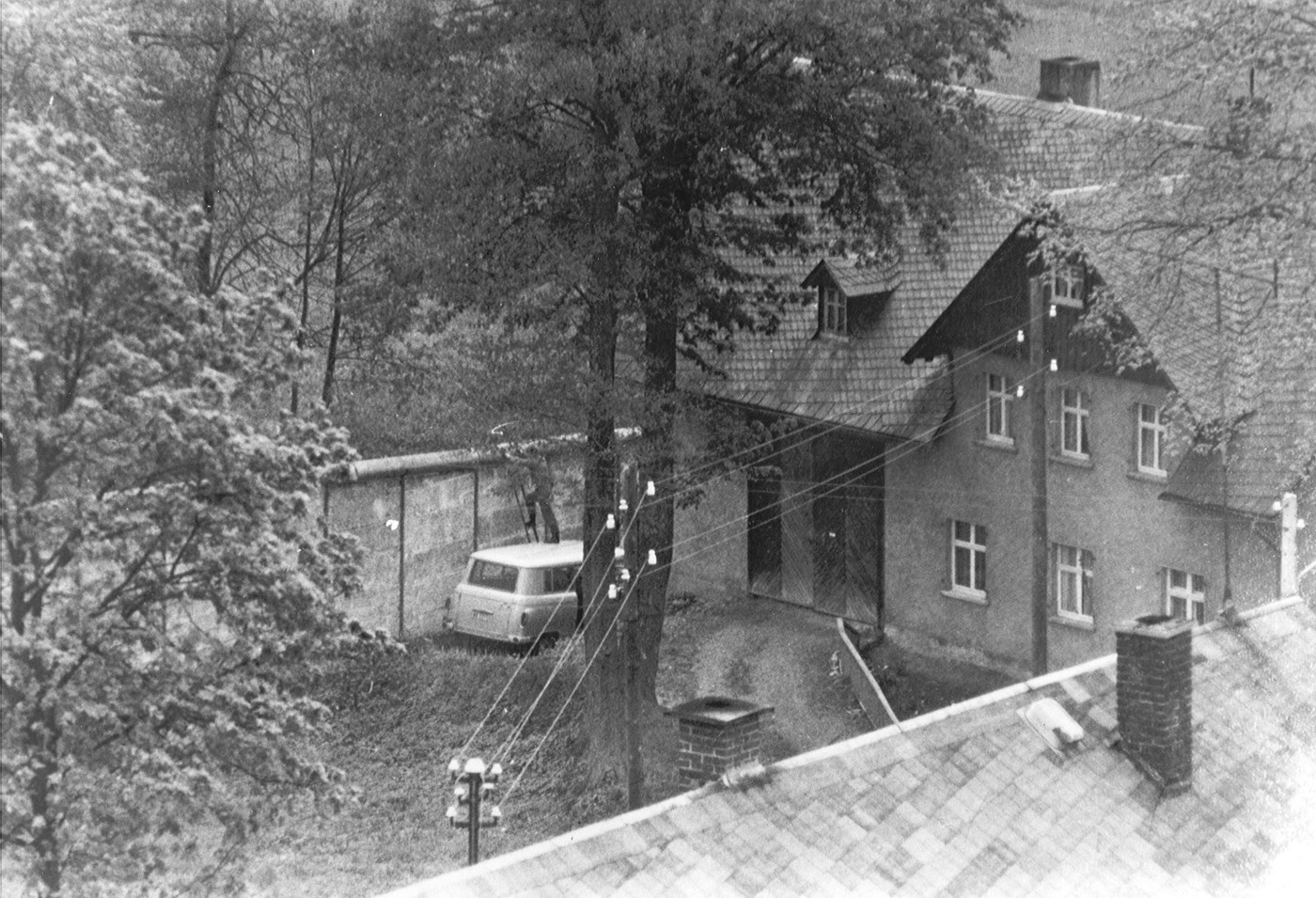
May 1973: Successful escape (reconstruction of the escape as part of the "crime scene inspection" by the GDR border troops) © Bundesarchiv-Militärarchiv Freiburg, DVH 53-5/138934
The white painted wall, at night eerily illuminated, the observation tower staffed by GDR border troops around the clock, the remains of the Upper Mill, the barrier behind which the connecting road ended - all that was to last for over 23 years.
1989, the year of the Peaceful Revolution, also left its mark on Mödlareuth: opening of the border in Hungary, mass departures from the GDR, embassy refugees, demonstrations in East Berlin, Leipzig, Plauen and many other places in the GDR, Honecker's resignation, Schabowski's press conference in Berlin and its consequences on the evening of November 9th... the fall of the wall in Berlin, the opening of the inner-German border.
After November 9th, new border crossings gradually emerged in many places. In Mödlareuth it was initially only possible to get from the western to the eastern part or vice versa via detours, i.e. via existing border crossings. A direct border crossing was not possible and the wall remained closed for the time being.
All along the border region, local demonstrations preceded the actual opening of border crossings, and so it happened in Mödlareuth. On the evening of December 5, 1989, a village meeting was held up on the Thuringian side, to discuss the new situation in place since November 9, 1989. The inhabitants of the Bavarian side lit candles and torches that evening, scanting: „The wall must fall“! The folks on the eastern side of Mödlareuth understood the calling, wandered to the wall and joined in. Nevertheless, the wall remained closed on that evening. Three days later, though, pioneers of the NVA border troops began to chop a 5 m wide gap into the wall. Some Mödlareuth workers on the East side seized the moment during their lunch break and slid through the new opening. Dramatic welcoming scenes followed on the Bavarian side. Due to repeated requests by the border patrol troops, they had to separate again for the time being, and the East-Mödlareuth residents returned back to the East side through the hole in the wall.
On December 9, 1989, exactly one month after the fall of the Berlin Wall, the border crossing in Mödlareuth was opened. A speech by Arnold Friedrich, the mayor of Töpen, was followed by greetings from the Chancellor of the FRG Dr. Helmut Kohl and American President George Bush Sr., who had already visited “Little Berlin” in February 1983 as Vice President at the time. Afterwards, the first thing both local mayors did was pass through the open gate in the wall. Over a thousand people from Bavaria, Saxony and Thuringia followed this example. After 37 years, the wall and barbed wire did no longer separate. A folk festival-like atmosphere and exuberant celebrations with beer, mulled wine, sparkling wine and Thuringian bratwurst characterized that day in Mödlareuth well into the night. But the gate in the wall initially only remained open from 8 a.m. to 10 p.m. At night it was closed again by the GDR border troops. To cross the border, German citizens needed a passport, and GDR citizens needed an identity card, each of which was stamped with a visa.
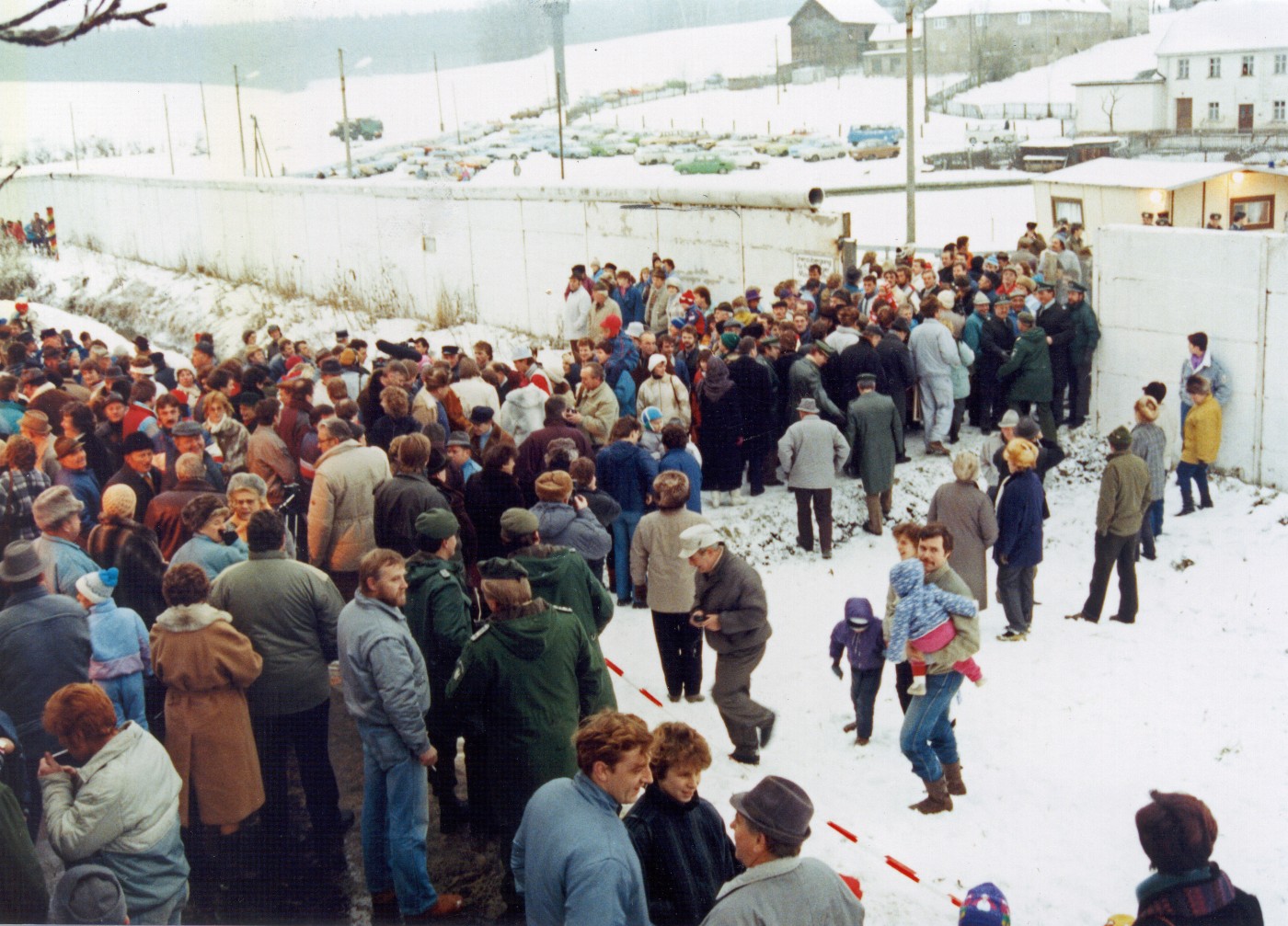
December 9, 1989: Opening of the Mödlareuth border crossing © Museum Mödlareuth ׀ Photo: BGP, Alfred Eiber
It was not until half a year later, on June 17, 1990, that the concrete wall was finally taken down for the most part. After the commemoration services on the occasion of the Popular Uprising of June 17, an excavator teared down the separating wall in the middle of the village, due to the initiative of the mayor of Töpen, Arnold Friedrich, who was now also mayor of Mödlareuth. With the fall of the wall, Arnold Friedrich's idea was born to create a museum about the history of the divided village of Mödlareuth – known as “Little Berlin“.
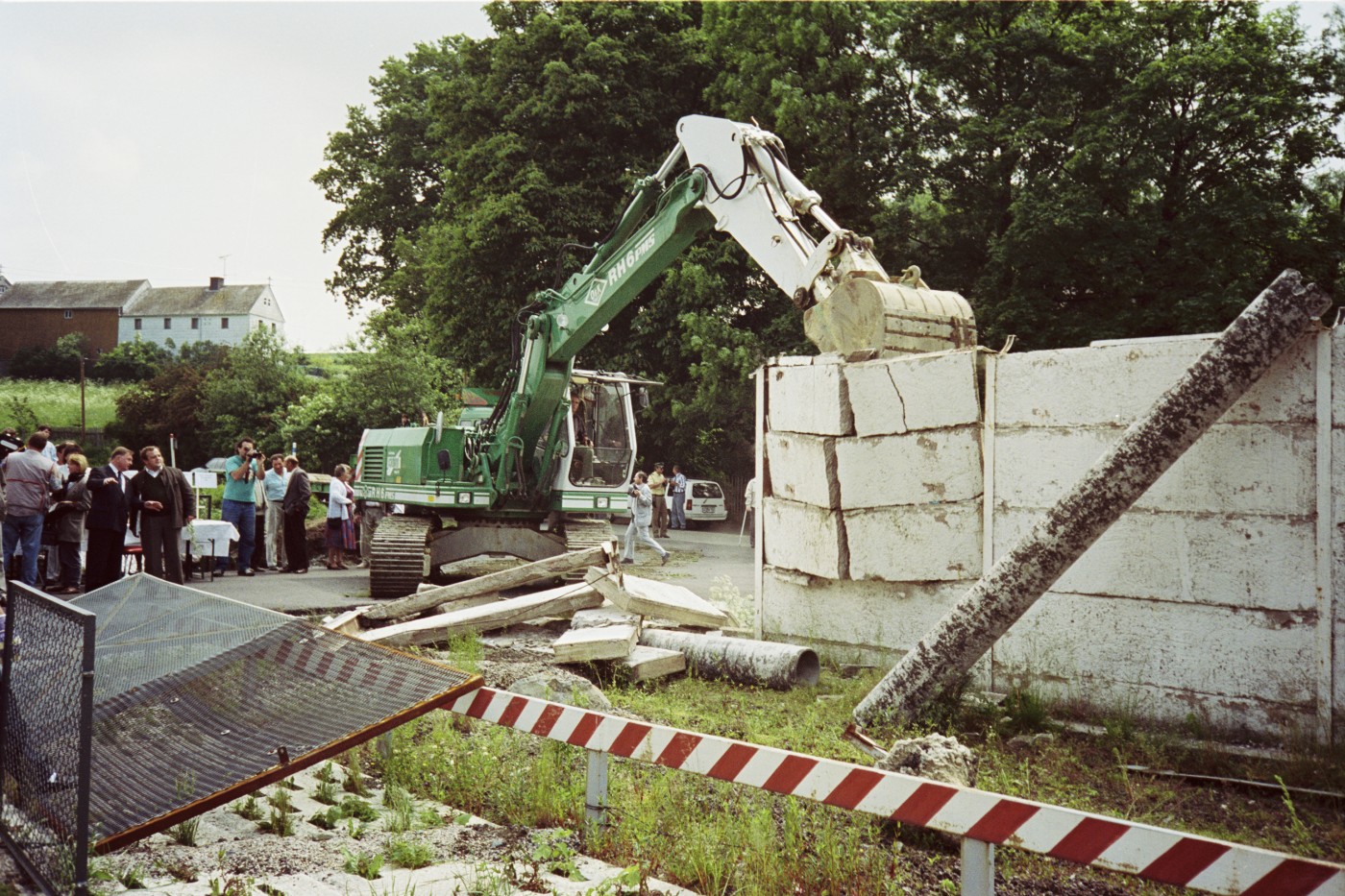
June 17, 1990: Partial demolition of the Mödlareuth wall on the occasion of the commemoration of June 17th © Museum Mödlareuth ׀ Photo: Arndt Schaffner
The village of Mödlareuth is still a “curiosity” today – one half Bavarian, the other half Thuringian. The Tannbach still forms the state border between the federal states of Bavaria and Thuringia. Different vehicle registration numbers, postal codes and telephone area codes are external signs of this administrative boundary. Two mayors look after the well-being of the 50 residents, whose affiliation is evident from their greeting: “Grüß Gott” on one side, “Guten Tag” on the other. But today everyday life is organized together again and festivals are celebrated together.
After 1990
A working group "Museum Mödlareuth" began its extensive and complex work shortly after the border was opened. On September 3, 1990 the association "Deutsch-Deutsches Museum Mödlareuth e.V." was founded.
As early as July 23, 1990, the Bavarian State Minister of the Interior, Dr. Edmund Stoiber, suggested with his letter to the Bavarian Prime Minister, Dr. h.c. Max Streibl, the construction of a memorial on the former Bavarian border with the GDR. In its decision of October 16, 1990, the Council of Ministers of the Bavarian State Government expressed the view that a memorial in the style of an open-air museum should be created on the former inner-German border between Bavaria, Saxony and Thuringia to commemorate the history of the division of Germany. Several possible locations were examined by the state office for non-state museums on behalf of the Bavarian State Ministry for Science and Art and Mödlareuth was favored as the location. From the beginning, the area around Mödlareuth was one of the most sensitive border sections of the former “western state border” of the GDR: the border triangle GDR/ČSSR/BRD, the Gutenfürst border station, the divided village of Mödlareuth, the leather factory in Hirschberg, the Rudolphstein/Hirschberg border crossing, the Rosenthal paper factory in Blankenstein and the slate quarries around Lehesten.
In 1991 the state of Bavaria began with financial subsidies for the museum, the the state of Thuringia followed in 1993.
The museum association took over the official trusteeship in 1995 within a special purpose agreement with the local authorities of Oberfranken, the counties of Hof, the Vogtlandkreis and the Saale-Orla-Kreis, as well as the municipality of Gefell and of the local authority of Töpen. After an expert opinion drawn up by the Enquete Commission of the German Bundestag, the Mödlareuth Museum became part of the German concepts for memorial sites and has been annually financially supported since then. It has been permanently supported by the state of Thuringia since 2005 and by Bavaria since 2006.
On December 9, 2005, the special-purpose association “Deutsch-Deutsches Museum Mödlareuth” was founded, which includes the Hof district, the Saale-Orla and Vogtland districts as well as the municipality of Töpen and the town of Gefell. This cross-border special purpose association took over the sponsorship of the museum on January 1, 2006. The federal government, the two free states of Bavaria and Thuringia as well as the district of Upper Franconia continue to contribute to the ongoing operating costs.
The aim of the Deutsch-Deutsches Museum Mödlareuth is to present the history of the division of Germany in its entirety. Not only the wall and barbed wire, but also the political, economical, societal and everyday historical aspects of this division are discussed. Where possible, information is explained using regional and local examples. The time frame begins in 1944/45 with the definition of the occupation zones and the end of the Second World War and ends with the Peaceful Revolution in 1989 and (re)unification in 1990 and their effects up to the present. The focus of the content is on the subject areas of border fortifications, border surveillance bodies, forced resettlements, border crossing points, “illegal border crossings”/escape, economic/traffic impacts, everyday life at the border as well as Peaceful Revolution and (re)unification.
At this historical location parts of the 700m long concrete barrier wall, the metal mesh fence and the observation tower have been preserved in their original form. Today's memorial has an open-air area, an exhibition area, museum educational rooms and a museum infrastructure with a media archive, archive, library and depots and is active in all fields of classic museum work (collecting, preserving, documenting, researching, communicating). It is an extracurricular learning location for current and future generations as part of historical-political education. Its purpose is to be a memorial to the crimes of the SED dictatorship, a place of remembrance of the German division and the memory of its victims.